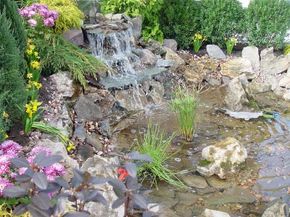Finishing a Pond
At this point, you're ready to install electric outlets and any underground plumbing you'll need for an external pump and waterfall features. Be sure you comply with local regulations on these points. Water and electricity are a deadly combination; be safe and call in a professional electrician. Some of the electric components you may need for your pond are a filter, pump, aerator and skimmer.
A filter removes waste materials from the water to keep the pond clean and clear. The pump circulates pond water through the filter to flowing water features, such as fountains or waterfalls. An aerator infuses water with oxygen, but if you have good circulation and surface area, you may not need one. A skimmer traps floating leaves and surface debris. It's usually installed just outside the pond perimeter.
Advertisement
Now comes the liner that started it all. Get someone to help you carry the liner to the pond and center it in the hole, making sure you have it right side up. Use hands and bare feet to form the liner to the contours of the pond, tucking and folding as necessary. Drape the excess liner over the edge and place a few smooth stones there and around the upper ledge to hold the liner in place while you fill the pond. Measure hose for the pump so that it draws water from the lowest level of the pond but doesn't touch the bottom. If you're using a submersible pump, you can put it into place.
Water volume will be indicated on pre-formed liners. Use the following formulas to determine volume of formal flexible liner ponds:
- Square or rectangle: length x width x depth x 7.5 = gallons
- Round: diameter x diameter x depth x 5.9 = gallons
- Oval: depth x width x length x 6.7 = gallons
[source: Lowe's]
For ponds with irregular shapes and varying depths, use the formula for oval ponds to get a rough estimate of volume. Attach a flow meter to your hose when you fill the pond to get a more accurate measurement. You'll need this figure if you need to medicate fish or treat the water with additives. It'll also come in handy if you want to install a heater to keep your fish warm and active during the winter.
Sweep dirt or debris from the liner, then start running water into the pond. The liner will shift and settle as the pond fills. Adjust the holding stones to prevent the liner from stretching under the weight of water. Rearrange folds as necessary. Allow the liner to settle for several days after the pond is full.
Finish the pond by placing your edging materials around it and trimming the excess liner. Use these scraps to pad stones, planters, pumps and fountains that you put inside the pond. Also, save a few to use as patches if something tears the liner.
Next, we'll show you how to fill your pond with life.
